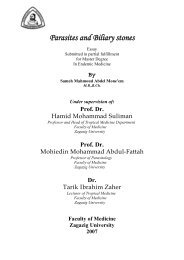E. Coli
E. Coli
E. Coli
You also want an ePaper? Increase the reach of your titles
YUMPU automatically turns print PDFs into web optimized ePapers that Google loves.
and Nguyen (1995) who reported moderate sensitivity to ampicillin<br />
also, this result agreed with Abd-El-Mawla (1998) who recorded<br />
sensitivity percentage 50% for ampicillin.<br />
1 out of 2(50%) Salmonella isolates from layer were sensitive to<br />
gentamycin this result agreed with that obtained by El-Ghamdi et<br />
al.,(1999) who recorded from resistance percentage ranged from 57%<br />
to 99.1% for gentamycin also, Lambie et al., (2000) reported that the<br />
isolates showing increasing trend of resistance to amoxicillin,<br />
paramecia, gentamycin, nitrofurance, norfloxacin and<br />
sulfamethazole/trimethoprime.<br />
No Salmonella isolates were sensitive to sulfamethazole/<br />
trimethoprime. this means that sulfamethazole/trimethoprime resistance<br />
percentage was 100%. This result agreed with that obtained by Poope<br />
et al.,(1995) who recorded sensitivity percentage 1.7% for<br />
sulfamethazole /trimethoprime and agreed with Lambie et al., (2000)<br />
who reported resistance for sulpha. And disagreed with resistance<br />
percentage 73.3% which obtained by El-Sayed (2001).<br />
No Salmonella isolates were sensitive to colistin this means<br />
resistance percentage 100%, this result agreed with Saha et al (1992)<br />
who found that Salmonella typhimuriun isolates showed resistance<br />
against commonly used antimicrobial agents.<br />
89
















